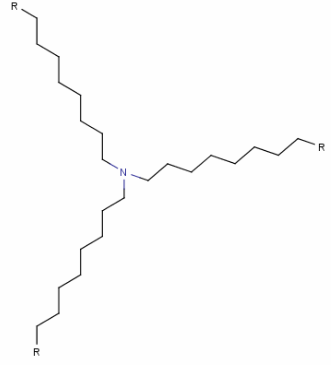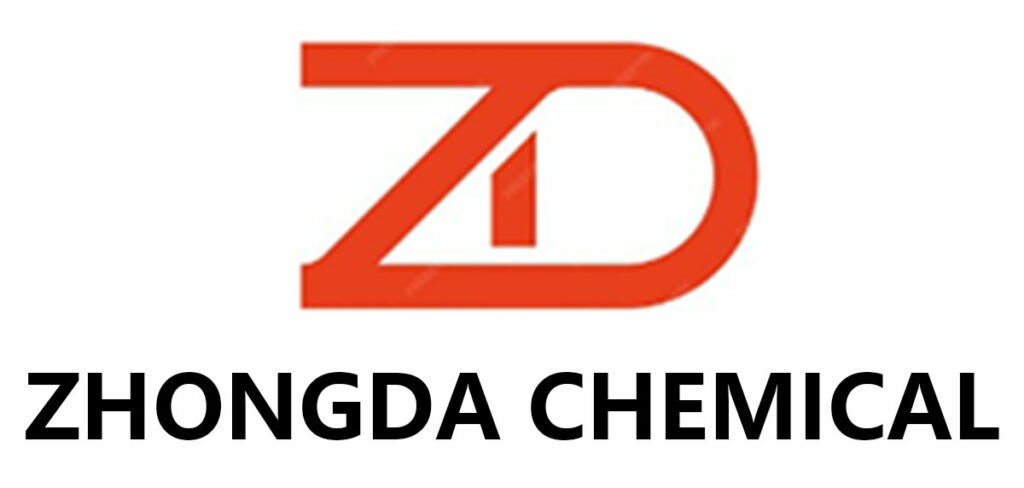Structure:
| Dehra | Colorless clear liquid |
| Formula | C27H57N |
| CAS Nru. | 68814-95-9 |
| KE Nru. | 214-242-1 |
| UN NO. | 3082 |
| KODIĊI HS | 2921199090 |
| Tertiary Amine % | ≥98 |
| Tertiary amine nitrogen content | ≥3.3 |
| Acid value(mg KOH/g) | 128-142 |
| Typical carbon chain % | C8 :35%-42% C10:52%-63% |
| Densità (20 ℃) g/ml | 0.81 |
| Flash Point℃: | ≥206 |
| Sinonimi | N235 7301 |
Trialkyl amines are typically colorless liquids or solids at room temperature, depending on the
length and nature of the alkyl groups.
Trialkyl amines often have a strong, fishy odor, especially in the case of lower alkyl chain lengths.
Trialkyl amines are generally soluble in organic solvents such as ethanol, methanol, and chloroform,
but their solubility in water varies depending on the alkyl groups. Smaller alkyl groups increase water
solubility, while larger alkyl groups decrease it.
Trialkyl amines are weak bases and can undergo protonation reactions. The basicity of a trialkyl amine
depends on the alkyl groups and their electron-donating or -withdrawing nature. Generally, tertiary
amines (trialkyl amines with three alkyl groups) are more basic than secondary or primary amines.
Trialkyl amines can participate in a variety of chemical reactions. For example, they can undergo alkylation
reactions where the alkyl groups are modified or substituted. They can also react with acids to form salts,
and they can be oxidized to form amine oxides.
The boiling point of a trialkyl amine depends on the size and nature of the alkyl groups. Generally,
trialkyl amines with longer alkyl chains have higher boiling points due to increased intermolecular forces.
Trialkyl amines are often used as catalysts in chemical reactions. They can facilitate reactions such as
esterification, transesterification, and Michael additions. Tertiary amines, in particular, are known for
their catalytic activity in various organic transformations.
Trialkyl amines are used in the synthesis of pharmaceutical compounds. They can be used as building
blocks or intermediates in the production of drugs, such as antihistamines, antidepressants, antivirals,
and local anesthetics.
Trialkyl amines can be employed as corrosion inhibitors to protect metals from degradation caused by
exposure to corrosive environments. They form a protective layer on the metal surface, preventing or
reducing corrosion.
Trialkyl amines can be used as surfactants, which are compounds that lower the surface tension between
two substances. They are utilized in various applications, including detergents, emulsifiers, fabric softeners,
and foaming agents.
Trialkyl amines can be incorporated into polymers as additives to enhance their properties. They can
improve the flexibility, adhesion, and thermal stability of polymers, making them suitable for applications
such as coatings, adhesives, and sealants.
Trialkyl amines are utilized in gas treatment processes, such as gas sweetening and carbon dioxide (CO2)
capture. They can absorb acidic gases, like hydrogen sulfide (H2S) and CO2, from natural gas or industrial
emissions, helping to purify the gas stream.
Trialkyl amines are versatile reagents in organic synthesis. They can participate in reactions like reductive
amination, acylation, and nucleophilic substitution, enabling the formation of various chemical compounds.
Trialkyl amines can act as initiators or co-catalysts in polymerization reactions. They can facilitate the
formation of polymers through processes such as radical polymerization or coordination polymerization.
The primary step is to choose the appropriate primary or secondary amine, which will be alkylated to form
the desired trialkyl amine. The alkylating agent, such as an alkyl halide (e.g., alkyl bromide, alkyl chloride)
or an olefin (e.g., alkene), is also selected based on the desired alkyl groups to be incorporated.
The alkylation reaction involves the reaction of the primary or secondary amine with the alkylating agent.
The reaction can be carried out under different conditions, such as in the presence of a solvent or a catalyst.
The reaction conditions may vary depending on the specific reactants and desired product.
After the alkylation reaction, the crude reaction mixture is typically purified to separate the desired
trialkyl amine from any unreacted starting materials or side products. Purification techniques such as
distillation, extraction, or chromatography may be employed to obtain a pure product.
The synthesized trialkyl amine is characterized using various analytical techniques, such as spectroscopy
(e.g., NMR, IR) and chromatography (e.g., GC, HPLC) to confirm its identity and purity.
• Incoming inspection: Il-materja prima ewlenija,huma spezzjonati għall-kontenut tagħhom, appearance and other
main properties.
• Feeding inspection: il-prinċipju ta ' l-għalf tal-materja prima huwa first-in-first-out, and the appearance of the
main raw materials is randomly inspected according to whether there is a big change in the storage
conditions before feeding.
• Batch sampling in the production process: Matul il-proċess tal-produzzjoni, the main indexes of each batch
of products: il-kontenut u l-valur tal-aċidu se jiġu eżaminati tliet darbiet f'perjodi ta 'żmien differenti.
• Storage Inspection: Kull lott (4tunnellati) jiġi spezzjonat qabel il-ħażna.
• Outbound inspection: Skond il-kwantità mitluba mill-klijenti, the products will be sampled
and inspected.
• Pre-shipment inspection: skond il-ħtieġa tal-klijent, third party inspection can be carried
out on the products before shipment.
• Physical Appearance: Spezzjoni viżwali
• Purity Analysis:Kromatografija tal-gass (GC)
• Acid Value:Titrazzjoni potenzjometrika
• Water Content:Analizzaturi tal-umdità
• Refractive Index:Rifrattometru
• Density:Miter tad-densità
Each batch of products should be accompanied by a certificate of conformity, including: the name of the
manufacturer, the name of the product, the production batch number, the net weight per barrel, the
quality level and the implementation of the standard number.weight, quality grade and implementation
standard number.
Packed in clean and dry plastic drums, net weight 200±0.3kg per drum or 1000±0.5kg, compressed and
sealed after each batch.
This product is packed in plastic drums, during transportation and loading/unloading, it should be carefully
and gently put down, and prevent from impact.
The storage place should be cool, dry and ventilated. Do fireproof and rainproof.

Il-kumpanija ssegwi l-kunċett ta ' “innovazzjoni kontinwa, l-insegwiment ta 'l-ewwel klassi”, u hija lesta li tipprovdi lill-klijenti domestiċi u barranin bi prodotti ta 'kwalità għolja u servizz sodisfaċenti.